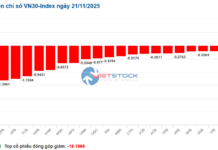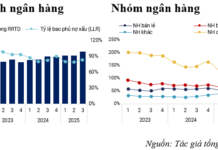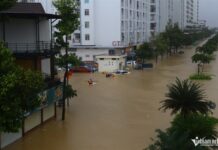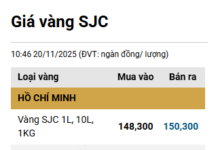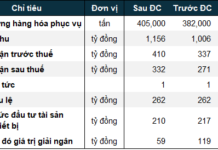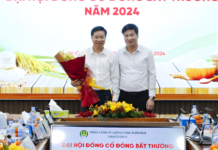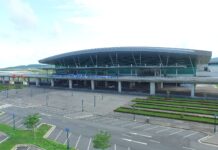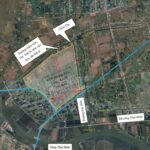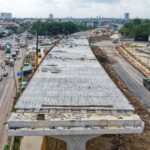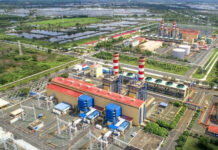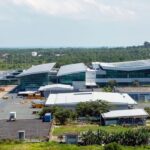Catalyst from Long Thanh Airport
In a report on the macroeconomic situation and an overview of the real estate market in the Southeast region, a representative from Batdongsan.com.vn emphasized that following the merger, Ho Chi Minh City and Dong Nai are showing positive development potential within the Southeast region. Notably, the GRDP growth rate is strong, particularly with the boost in public investment driving economic development.

Data from Batdongsan.com.vn indicates that increased public investment is fueling economic growth in Dong Nai specifically and the Southeast region generally.
Recently, Long Thanh Airport Phase 1 has entered its final construction sprint, beginning recruitment of tens of thousands of workers to ensure its launch in the first half of 2026. This is expected to positively impact the socio-economic landscape and real estate market across the eastern region of Ho Chi Minh City, particularly in Long Thanh and Nhon Trach (Dong Nai).
Notably, with Phase 1 of the Long Thanh Airport project nearing completion, the Ministry of Construction is advocating for mechanisms to expedite the launch of Phase 2. This phase will include an additional passenger terminal and a runway. The Ministry is seeking expedited project approval to bypass National Assembly ratification.
According to the Ministry of Construction, Phase 1 of Long Thanh Airport will feature a terminal with a capacity of 25 million passengers per year, two runways, air traffic control infrastructure, ground services, and aviation authority offices.
Phase 2 will add another runway and a passenger terminal with a capacity of 25 million passengers per year, bringing the total capacity to 50 million passengers annually. The total investment for Phase 2 is approximately VND 48,000 billion, with implementation scheduled from 2028 to 2032.

Once completed, Long Thanh Airport will not only serve as a transportation hub but also foster the development of service ecosystems, creating an “airport city” model.
Long Thanh Airport is a key national project expected to become a leading modern aviation gateway, enhancing Vietnam’s international transit capacity. This “mega-project” will not only serve as a transportation hub but also drive the development of surrounding service, commercial, and residential ecosystems, establishing an “airport city” model. It is a significant catalyst for the real estate market in the eastern region of Ho Chi Minh City and Dong Nai.
Launch of Key Infrastructure Projects
Critical road networks connecting Ho Chi Minh City and Dong Nai are creating a convenient regional transportation network, reducing distances between localities, and boosting the socio-economic landscape and real estate market.
Recently, Ho Chi Minh City and Dong Nai agreed to accelerate several key infrastructure projects, prioritizing Cat Lai Bridge, Phu My 2 Bridge, and Dong Nai 2 Bridge. These projects, with investments totaling tens of trillions of VND, will significantly shorten travel times between the two regions.

Infrastructure development is a key driver of socio-economic growth and the real estate market.
Additionally, Dong Nai is proceeding with the upgrade of Provincial Road 769, reducing travel time from the airport to the Central Highlands and South Central regions. The project spans nearly 30 km with an initial investment of over VND 6,200 billion.
Several bridge projects are also being planned and prepared for investment in the eastern region to enhance connectivity between Ho Chi Minh City and Dong Nai. Previously, Nhon Trach Bridge on Ring Road 3 was inaugurated, and the Phuoc Khanh Bridge on the Ben Luc – Long Thanh Expressway is nearing completion, promising expanded regional development.
According to the master plan, Ho Chi Minh City and Dong Nai will have five railway and urban rail lines, including: the extended Ben Thanh – Suoi Tien metro to Dong Nai; the former Ba Ria – Vung Tau urban railway connecting to Long Thanh Airport; the Bien Hoa – Vung Tau national railway; the Bau Bang – Cai Mep national railway; and the Thu Thiem – Long Thanh national railway. Notably, the Thu Thiem – Long Thanh railway and Ho Chi Minh City’s metro line 2 are critical links directly connecting Tan Son Nhat Airport with Long Thanh Airport.
Dong Nai is also promoting the extension of metro line 1 (Ben Thanh – Suoi Tien) from Ho Chi Minh City through the province to Long Thanh Airport, with a preliminary investment of VND 65,000 billion.
Thus, during the 2026-2030 period, as these projects are completed, the distance between Ho Chi Minh City and Dong Nai will be significantly reduced in terms of both space and development opportunities, impacting the socio-economic landscape and real estate market.

Nhon Trach area, with direct infrastructure connectivity to Long Thanh Airport.
Furthermore, the latest information from Dong Nai indicates that the 2026 land price table is expected to increase significantly, up to nine times the current rate. This adjustment signals a clear commitment to enhancing land management efficiency and aligning asset valuation with market prices. This change will provide a substantial boost to the real estate market. Projects in Dong Nai, particularly in Nhon Trach, will benefit doubly. The anticipated land price increase will drive up asset values and capitalize ongoing and licensed projects.
Specifically, in Nhon Trach, which has direct infrastructure connectivity to Long Thanh Airport, projects like FIATO Airport City by Thang Long Real Group will become even more attractive to investors, confirming their sustainable profit potential in the near future.
Located on Ton Duc Thang Street (25B), this project benefits from its position between the Thu Thiem – Long Thanh metro stations, offering residents just a 5-minute commute to Long Thanh Airport—a prime location for future investment opportunities.
Notably, the handover of the Galaxy block in Q4/2026 holds significant meaning, as Long Thanh Airport will have been operational since early 2026. This ensures that the project’s commercial podium will attract a steady stream of customers from day one, including airport personnel, local residents, and tourists. This is a critical factor for investors owning commercial units to optimize business potential and sustainably increase asset value.
According to Batdongsan.com.vn, with its strategic location, Dong Nai is a promising area within the expanded urban landscape, logistics, seaports, and airports east of Ho Chi Minh City. Recently, interest in real estate in the area has surged, with a significant portion of inquiries coming from Hanoi.
Accelerating the Construction of Son Hai Group’s Proposed Highway: Vietnam’s Most Stunning Mountain-Crossing Project
The Nha Trang – Lien Khuong Expressway has been proposed for investment and construction before 2030 to meet the urgent demand for transportation infrastructure development.

